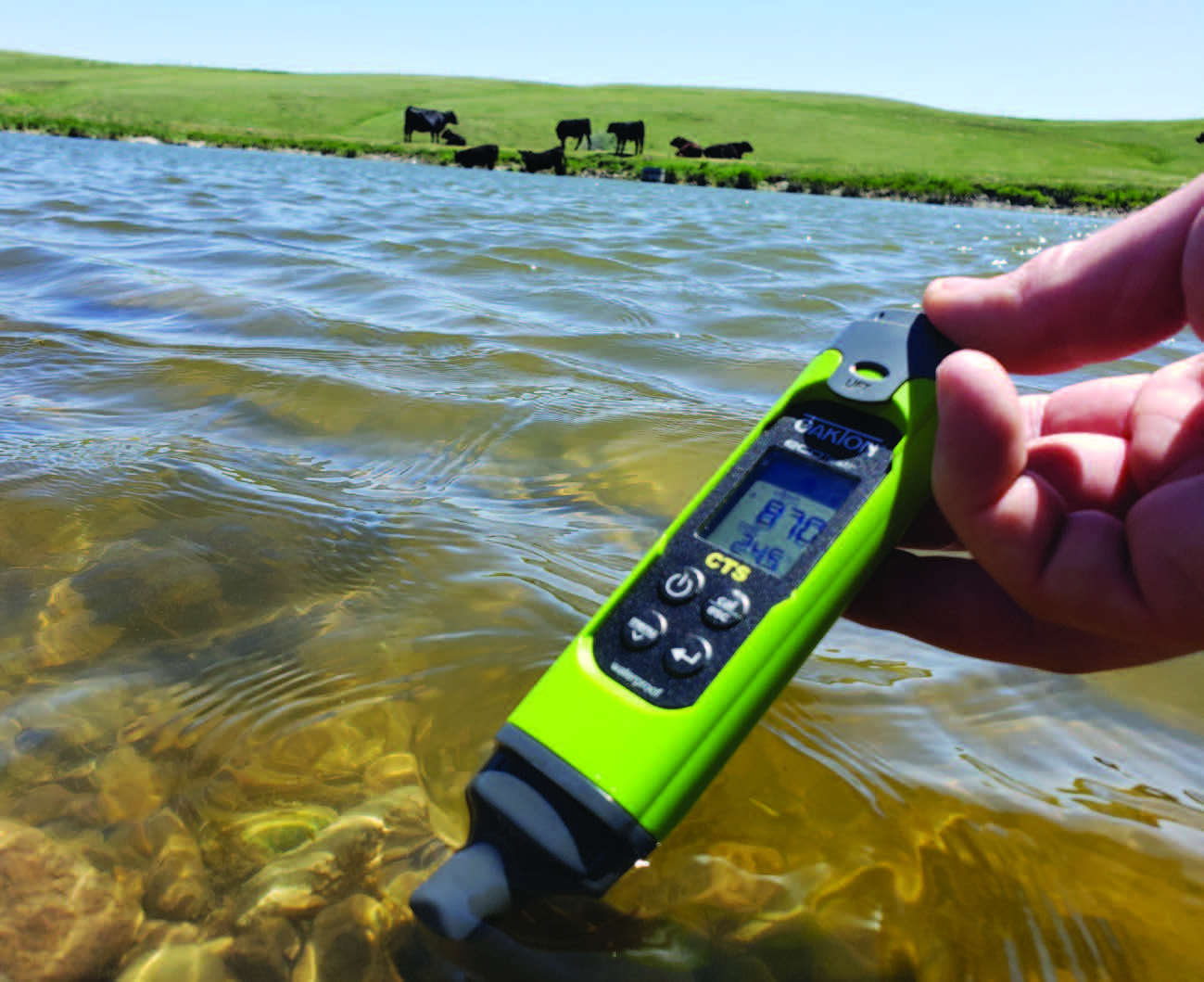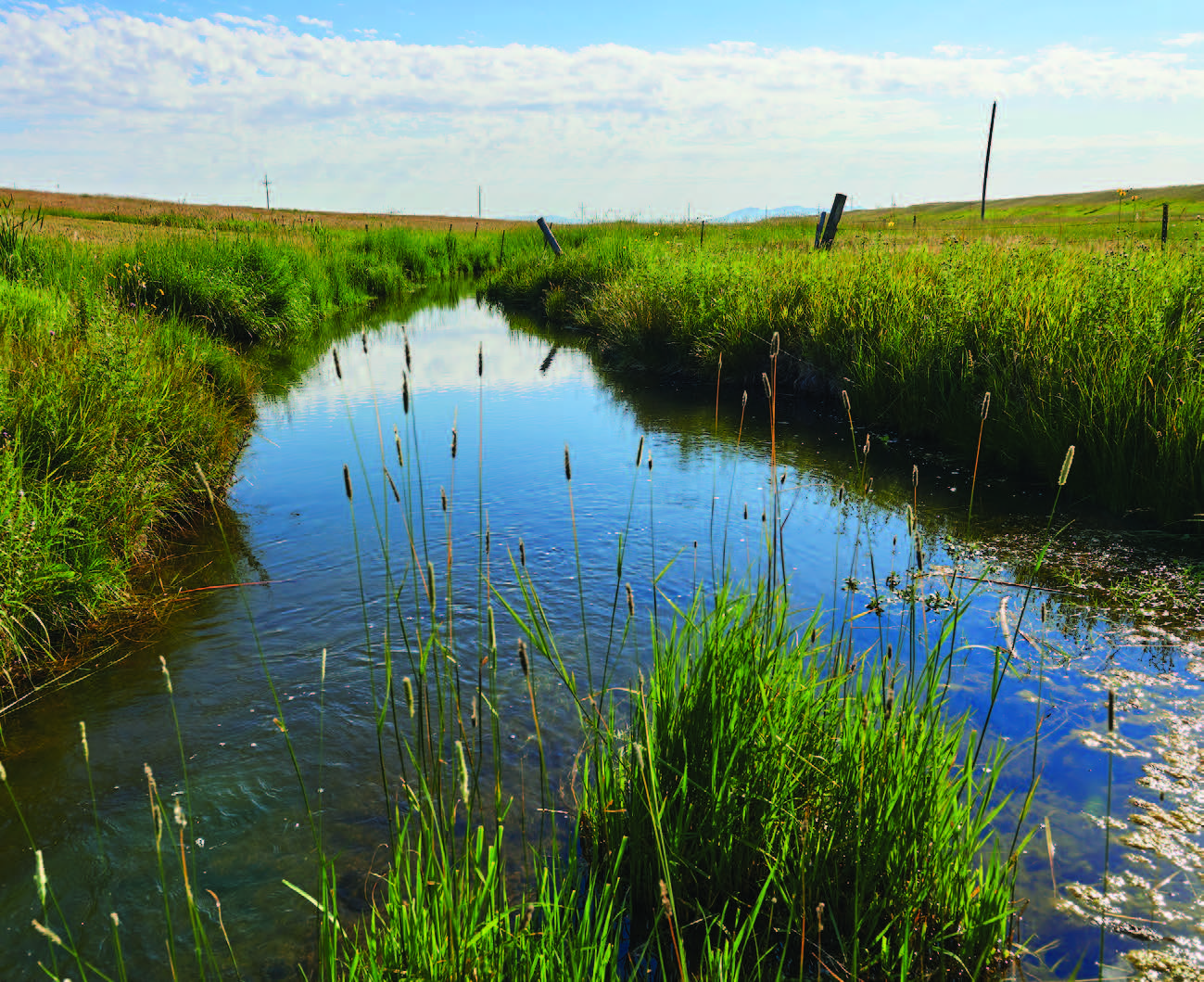Water Quality for Livestock
All animals require water to live and thrive, and water is the most essential nutrient
for livestock health. Water requirements for livestock vary greatly depending on temperature,
animal size, production stage, and moisture content of the diet. Water intake drives
feed intake, so if water intake decreases, feed intake will decrease as well. Poor
water quality can compromise livestock health and can affect water intake, which also
negatively impacts health. Common water quality issues in Montana vary by location
but include salinity, sulfate, nitrate, bacteria, and cyanobacteria.
Total dissolved solids (TDS) is the sum of all the dissolved minerals, metals, and nutrients in water and is sometimes simply referred to as salinity. High TDS (high salinity) water can dehydrate animals, and Table 1 summarizes TDS levels suitable for livestock use. The table also includes specific conductance values that can be used to estimate TDS with a handheld meter (discussed below). TDS is generally highest in Montana water sources east of the continental divide, while western Montana has fewer issues with TDS in livestock water sources. Surface water and shallow wells can see large changes in TDS over a season, while deeper groundwater tends to have more stable TDS levels. Water with high TDS may also have high concentrations of sulfate or nitrate.
High sulfate concentrations cause issues with livestock water sources in much of central and eastern Montana. High sulfate concentrations in water can also lead to polioencephalomalacia (PEM or polio), a neurological disorder that is commonly fatal. Symptoms of PEM include seizures, blindness, ataxia (loss of coordination), and recumbency (leaning, resting, reclining). Livestock owners should be especially aware of water sulfate concentrations when feeding high-sulfur feedstuffs. Sulfate concentrations below 1,000 mg/L are generally safe for livestock, values in the 1,000-3,500 mg/L range cause increasing health issues, and concentrations above 3,500 mg/L cause significant health issues and death.
Table 1. Total dissolved solids, approximate specific conductance, and suitability for livestock use
| Total Dissolved Solids (≈ Specific Conductance) |
Suitability for Livestock |
| Less than 1,000 mg/L (≈ SC < 1.5 mS/cm) |
Relatively low in salinity. Excellent for all classes of livestock and poultry. |
| 1,000 – 2,999 mg/L (≈ SC 1.5 to 5 mS/cm) |
Very satisfactory for all classes of livestock and poultry. May cause temporary and mild diarrhea in livestock not accustomed to the water. |
| 3,000 – 4,999 mg/L (≈ SC 5 to 8 mS/cm) |
Satisfactory for livestock but may cause temporary diarrhea or be refused at first by animals not accustomed to the water. Poor water for poultry. |
| 5,000 – 6,999 mg/L (≈ SC 8 to 11 mS/cm) |
Can be used with reasonable safety for cattle, sheep, swine, and horses. Avoid use for pregnant or lactating animals. Not acceptable for poultry |
| 7,000 – 10,000 mg/L (≈ SC 11 to 16 mS/cm) |
Considerable risk for pregnant or lactating cows, cattle in confinement, horses, sheep, or young animals. In general, should avoid use. Unfit for poultry and swine. |
| More than 10,000 mg/L (≈ SC > 16 mS/cm) |
Extremely high risk. Not recommended for use under any conditions. |
Note: If an SC reading is greater than 5 mS/cm (or 3,000 mg/L as TDS), consider testing for sulfate.
|
Units of Concentration: mg/L = ppm Converting Specific Conductance (SC) to Total Dissolved Solids (TDS)
|
Nitrate concentrations in water are typically low, but nitrate may leach from soil into groundwater, leading to high concentrations in springs or shallow wells. Nitrate-N concentrations below 40 mg/L are safe for livestock, while concentrations above 100 mg/L can be toxic. Intermediate nitrate concentrations should be considered in combination with nitrate levels in feed. Forage nitrate toxicity information may be found in the “Nitrate Toxicity of Montana Forages” MontGuide (MT200205AG). https://store.msuextension.org/Products/Nitrate-Toxicity-of-Montana-Forages-MT200205AG__MT200205AG.aspx.
Cyanobacteria, also known as blue-green algae, are a specific type of algae that can release toxins, causing Harmful Algal Blooms (HABs). Green algae does not release toxins and does not cause HABs, so distinguishing between cyanobacteria and green algae is important. Cyanobacteria often looks like green pea soup or paint scum floating on the water surface that may turn blue. If a stick is dipped into a cyanobacteria bloom, it commonly comes out looking like it is coated in paint. This is in contrast to algae dangling off the stick, which indicates filamentous green algae or submerged plants (macrophytes), which do not release toxins. If a cyanobacteria bloom is identified, the only way to protect livestock from the risk of exposure to toxins is to remove them from the water source, since it is not possible to predict toxin release when cyanobacteria are present. Dead animals found near a water source (mice, birds, etc.) are an indicator that toxins may be present. If there is concern that a bloom may be cyanobacteria, a picture of the bloom can be submitted to the Montana HABs website (http://hab.mt.gov) for a professional to assess whether the algae is cyanobacteria. If the bloom is identified as cyanobacteria, assistance is available through the website to test for presence of toxins.
Bacteria are another common water contaminant that can compromise livestock health. High bacteria concentrations in livestock drinking water can cause infertility, foot rot, and low milk production. Manure contamination of stagnant water sources is a common source of bacteria and can also contribute to blue-green algae problems, which can be toxic to livestock.
Testing water quality for livestock can be approached with simple field-based methods for rough estimates, or by sending a sample to a water quality lab. Simple handheld meters can estimate TDS using electrical conductivity. Many MSU Extension offices have meters, or they can be purchased for around $100. When using a meter, it is important to check accuracy at least once a month with a calibration solution. For sulfate and nitrate, test strips are commercially available that can provide a rough estimate of concentration in the field in a few minutes. Laboratory testing is necessary to provide accurate water quality information and a list of certified labs is available through the MSU Extension Water Quality website.

Photos: Adam Sigler, MSU Extension
Periods of limited precipitation and drought conditions are common in Montana and can exacerbate water quality issues. During these periods, producers commonly have few options and need to haul water to livestock. In some cases, diluting poor quality water with hauled water, treating with reverse osmosis, or infrastructure for rainwater storage can provide additional options. See the MSU Extension “Water Quality for Livestock” MontGuide (MT202209AG) https://store.msuextension.org/Products/Water-Quality-for-Livestock-MT202209AG__MT202209AG.aspx for more detailed information on all the topics covered in this article.
ADDITIONAL INFORMATION
MSU Extension Water Quality – livestock water suitability website: https://waterquality.montana.edu/well-ed/interpreting_results/fs_livestock_suitability.html

Photo: Kelly Gorham, MSU
Adam Sigler is the MSU Extension Water Quality Specialist; Marley Manoukian is the Richland County MSU Extension Agent.
